Restored by The Film Foundation’s World Cinema Project and Cineteca di Bologna in collaboration with Bahram Beyzaie. Funding provided by the Hobson/Lucas Family Foundation.

The World Cinema Project (WCP) preserves and restores neglected films from around the world. To date, 63 films from Africa, Asia, Eastern Europe, Central America, South America, and the Middle East have been restored, preserved and exhibited for a global audience. The WCP also supports educational programs, including Restoration Film Schools; intensive, results-oriented workshops allowing students and professionals worldwide to learn the art and science of film restoration and preservation. All WCP titles are available for exhibition rental by clicking "Book This Film."
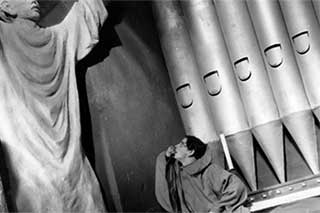
DOS MONJES
TWO MONKS
Director: Juan Bustillo Oro
WRITTEN BY: Juan Bustillo Oro, José Manuel Cordero
EDITING: Juan Bustillo Oro
DIRECTOR OF PHOTOGRAPHY: Agustín Jiménez
PRODUCER: José San Vicente, Manuel San Vicente
MUSICAL DIRECTOR: Max Urban
PRODUCTION DESIGN: Mariano Rodríguez, Granada, Carlos Toussaint
STARRING: Víctor Urruchúa, Carlos Villatoro, Beltrán de Heredia, Emma Roldán, Magda Haller
COUNTRY OF PRODUCTION: Mexico
LANGUAGE: Spanish with English subtitles
COLOR INFO: Black and White
RUNNING TIME: 85 minutes
PRODUCTION COMPANY: Proa Films
PRODUCER: José San Vicente, Manuel San Vicente
Restored by The Film Foundation’s World Cinema Project at L’immagine Ritrovata laboratory in collaboration with Filmoteca de la UNAM and Cinémathèque française. Restoration funded by the Material World Charitable Foundation.

RAID INTO TIBET
Director: Adrian Cowell
DIRECTOR OF PHOTOGRAPHY: Chris Menges
PRODUCER: George Patterson
COUNTRY OF PRODUCTION: UK
LANGUAGE: English/Tibetan with English subtitles
COLOR INFO: Black-and-White
RUNNING TIME: 28 minutes
PRODUCER: George Patterson
Restored by The Film Foundation’s World Cinema Project at Cineric Inc. laboratory in association with the Tibet Film Archive. Special thanks to the Cowell family.
In May 1964, three British filmmakers traveled with the Khampa guerrillas over a 20,000-foot pass into occupied Tibet from the remote Tsum region of Nepal and captured dramatic footage of an ambush on a Chinese military convoy. The footage was smuggled out and edited two years later in London, and officially released in 1966 to critical acclaim. Shot by Oscar-winning cinematographer Chris Menges (THE READER, LOCAL HERO, THE KILLING FIELDS), this documentary short is an important historical artifact, representing the only known footage of armed Tibetan resistance fighters in combat with the Chinese.
NOTES ON THE RESTORATION:
Restoration work was completed at Cineric in New York. The original 16mm camera negative was cleaned, repaired, then wet-gate scanned at 4K to eliminate scratches and other minor defects in the emulsion. The image was subsequently stabilized and digitally cleaned to remove dust, deep scratches, and other visible marks. Because of the extreme conditions in Tibet during the filming, Cineric implemented exposure compensation at the initial scanning of the raw material. Grading was performed by colorist Paul Ensby and supervised by Chris Menges at Technicolor London.
The original sound negative was also scanned and digitally cleaned to reduce background noise and remove clicks and pops. A new 35mm internegative with sound has been made for preservation, along with 35mm prints for conservation and access. In addition, a new HD master and DCP will be produced for digital screenings.
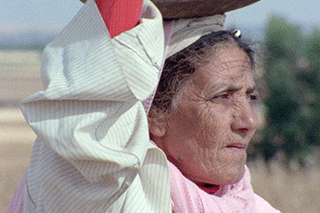
ALYAM, ALYAM
Director: Ahmed El Maanouni
WRITTEN BY: Ahmed El Maanouni
EDITING: Martine Chicot
DIRECTOR OF PHOTOGRAPHY: Ahmed El Maanouni
MUSICAL DIRECTOR: Nass el Ghiwane
SOUND: Ricardo Castro
PRODUCTION DESIGN: Rabii Films
STARRING: Toualàa villagers (Oulad Ziane) in the Casablanca region, and in particular: Abdelwahad and his family, Tobi, Afandi Redouane and Ben Brahim
COUNTRY OF PRODUCTION: Morocco
LANGUAGE: Arabic, French with English subtitles
COLOR INFO: B&W
RUNNING TIME: 90 minutes
Restored by Cineteca di Bologna/L’Immagine Ritrovata laboratory, in association with Ahmed El Maanouni. Restoration funded by The Film Foundation’s World Cinema Project.
Alyam, Alyam is a film about shattered dreams and the circumstances leading up to that point; about the shaking of the traditional social structure; about the strength born of desperation and the unrelenting dissipation of lost generations. This is stressed from the first notes of the opening music, by the strangely empty building frame that is slowly filled with people, by the village space, by the silence of the wandering woman who smokes, until the last shot of the film, when a crowd appears from behind a deserted hill. The dreams of a society growing smaller, unable to hold on to the resources that could help it survive, are mirrored by the mother’s helpless prayer, “I need your shadow, I need your light, I need your face.”
I simply wanted to show the farmers’ faces, to honor their sounds and their images, their silences and their words, and that’s why I chose not to interfere and to opt for deliberately restrained composition, movement and mise-enscène. I tried to minimize the camera’s ability to distort, make a point, or discriminate. I wanted each aspect to be presented equally. I did not look for spectacular beauty, but made an effort to let the imagery of the rural world speak through abstraction and silence.
Almost 40 years later, when I watch Alyam, Alyam again, I am still comfortable with my aesthetic choices and my intuitions, but I cannot avoid noticing how, from beginning to end – from the opening shots with the blood shed by the camels, to the crowd of peasants appearing from behind the hills – it all seemed to presage the current tragedy experienced by the thousands whose broken dreams lie at the bottom of the Mediterranean, on which the voice of Nass El Ghiwane’s Larbi Batma seems to strangely resonate: “Alyam, Alyam, oh, those were the days! Why are you crossed? Who changed your course? You were once sweet like milk, now you’re bitter. I love all men as if they were my brothers. My brothers have crushed me. I will silence my pain and let my love be loud.”- Ahmed El Maanouni
NOTES ON THE RESTORATION:
The restoration of Alyam, Alyam used the 16mm A/B rolls original camera and sound negatives preserved at Eclair Laboratories, where the 4K scan was performed. Restoration - carried out at Cineteca di Bologna/L’Immagine Ritrovata - succeeded in stabilizing the image and bringing the original chromatic qualities to light. Director Ahmed El Maanouni supervised the color grading process and approved the final restoration.
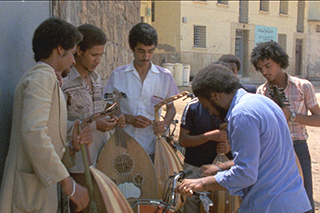
TRANCES
EL HAL
Director: Ahmed El Maanouni
WRITTEN BY: Ahmed El Maanouni
EDITING: Jean-Claude Bonfanti
DIRECTOR OF PHOTOGRAPHY: Ahmed El Maanouni
PRODUCER: Izza Génini
MUSICAL DIRECTOR: Nass El Ghiwane
STARRING: Nass El Ghiwane
COUNTRY OF PRODUCTION: Morocco
LANGUAGE: Arabic
COLOR INFO: Color
RUNNING TIME: 87 minutes
PRODUCTION COMPANY: OHRA/SOGEAV
PRODUCER: Izza Génini
Restored in 2007 by Cineteca di Bologna/L’Immagine Ritrovata laboratory, in association with The Film Foundation’s World Cinema Project, Ahmed El-Maanouni, and Izza Genini. Restoration funded by Armani, Cartier, Qatar Airways and Qatar Museum Authority.
“It was in 1981 while I was editing a film, The King of Comedy. We worked at night so no one would call us on the telephone and I would have television on, and one channel in New York at the time, around 2 or 3 in the morning, was showing a film called Transes. It repeated all night and it repeated many nights. And it had commercials in it, but it didn’t matter. So I became passionate about this music that I heard and I saw also the way the film was made, the concert that was photographed and the effect of the music on the audience at the concert. I tracked down the music and eventually it became my inspiration for many of the designs and construction of my film The Last Temptation of Christ. […] And I think the group was singing damnation: their people, their beliefs, their sufferings and their prayers all came through their singing. And I think the film is beautifully made by Ahmed El Maanouni; it’s been an obsession of mine since 1981 and that is why we are inaugurating the Foundation with Trances.” –Martin Scorsese, May 2007
NOTES ON THE RESTORATION:
Notes on the restoration
The restoration of Trances used the original 16mm camera and sound negative provided by producer Izza Génini. The camera negative was restored both photochemically and digitally and blown-up to 35mm format. The sound negative was restored to Dolby SR and digital.
Image: © Courtesy of OHRA-Izza Génini
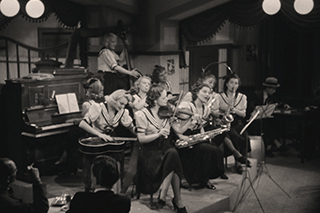
TWO GIRLS ON THE STREET
KÉT LÁNY AZ UTCÁN
Director: André De Toth
WRITTEN BY: Tamás Emod, Rezsö Török
EDITING: Zoltán Kerényi
DIRECTOR OF PHOTOGRAPHY: Károly Vass
ADAPTED BY: André De Toth
PRODUCER: Béla Lévay
FROM: Hungarian National Film Archive
PRODUCTION DESIGN: Gizella Langermann
STARRING: Bella Bordy (Torma Vica), Mária Tasnádi Fekete (Kártély Gyöngyi), Piroska Vaszary Pletyus (as Vaszary Piri), Gyula Csortos (Filc bácsi), Andor Ajtay, Csiszár István, Károly Kovács, Lali
COUNTRY OF PRODUCTION: Hungary
LANGUAGE: Hungarian with French and English subtitles
COLOR INFO: Black and White
RUNNING TIME: 85 minutes
PRODUCTION COMPANY: Hunnia Filmgyár
PRODUCER: Béla Lévay
Restored in 2010 by Cineteca di Bologna/L'Immagine Ritrovata laboratory, in association with The Film Foundation’s World Cinema Project and Magyar Nemzeti Filmarchívum. Restoration funded by Armani, Cartier, Qatar Airways and Qatar Museum Authority.
André De Toth was a great filmmaker, we are indebted to him for a number of extraordinary films (dating back to his first Hungarian works) and many masterpieces. He fought to make ambitious films and refused to work under a studio contract, thus showing a rare desire for freedom […] One day, following a screening of Round Midnight, De Toth told me, “You made me cry. And it’s hard to cry when you only have one eye.” He comforted and supported me. He was never bitter, he would never have said something like: “Cinema was better when I was making films”. He remained curious, open-minded; he battled for the American Cinematheque on Hollywood Boulevard […] “We’re like passengers driving at full speed on the new highways of communication”, he wrote. “It’s the same road since 1895, only it’s slippier because of the sweat and the blood and with more cracks: each of them a broken dream. These past hundred years have been terrible, yet we’ve enjoyed every single minute of them. As long as this fever, this love for making films survives, nothing will ever change.” On his sets, one big sign read, “Drama should occur in front of the camera, not behind it”, another, “Technology will never replace brains and intelligence”.
(Bertrand Tavernier)
NOTES ON THE RESTORATION:
The restoration of Két Lány Az Utcán used the original 35mm camera and sound nitrate negatives preserved at the Magyar Nemzeti Filmarchívum (Hungarian National Film Archive). The digital restoration produced a new 35mm internegative.
Image: © Courtesy of Magyar Nemzeti Filmarchívum (Hungarian National Film Archive)
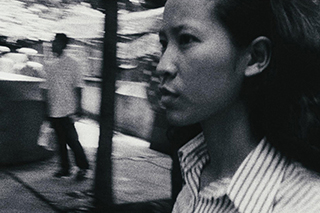
Mysterious Object at Noon
DOKFAH NAI MEU MAAN
Director: Apichatpong Weerasethakul
EDITING: Mingmongkol Sonakul, Apichatpong Weerasethakul
DIRECTOR OF PHOTOGRAPHY: Apichatpong Weerasethakul, Prasong Klimborron
PRODUCER: Gridthiya Gaweewong, Mingmongkol Sonakul
SOUND: Teekadetch Watcharatanin, Sirote Tulsook, Paisit Phanpruksachat, Adhinan Adulayasis
STARRING: Somsri Pinyopol, Duangjai Hiransri, To Hanudomlapr, Kannikar Narong, and the villagers of Thailand
COUNTRY OF PRODUCTION: Thailand
LANGUAGE: Thai
COLOR INFO: Black and White
RUNNING TIME: 88 minutes
PRODUCTION COMPANY: 9/6 Cinema Factory, Firecracker Films, Bangkok
PRODUCER: Gridthiya Gaweewong, Mingmongkol Sonakul
Restored in 2013 by the Austrian Film Museum and Cineteca di Bologna/L’Immagine Ritrovata laboratory, in association with The Film Foundation’s World Cinema Project, LISTO laboratory in Vienna, Technicolor Ltd in Bangkok, and Apichatpong Weerasethakul. Restoration funded by Doha Film Institute.
On his journey, the director hears a story which he then asks people to continue as they wish— like a game of Chinese Whispers (and relating also to the French Surrealists’ concept of the “cadavre exquis”). The original title, Dokfah nai meu maan, roughly translates as Heavenly Flower in Devil’s Hand. The name of that flower, Dokfah, is also the name of the woman who appears in the story-within-a-film as the teacher of a young paraplegic boy. The title is reminiscent of an archetypical Thai melodrama, but in the hands of the most imaginative re interpreter of national tradition, it becomes an epic meta-narrative.
I want to give the audience the freedom to fly or to float, to just let their mind go here and there, to drift, like when we sit in a train, listen to a Walkman, and look at the landscape. It is liberating, and also the audience understands that they are not watching a routine, three act narrative.
- Apichatpong Weerasethakul
NOTES ON THE RESTORATION:
The restoration of Mysterious Object at Noon utilized the 35mm duplicate negative with burned-in English subtitles deposited at the Austrian Film Museum by Apichatpong Weerasethakul in 2007. This negative was struck in 1999 from the (now lost) original 16mm camera reversal element.
The duplicate negative was scanned at 3K at the Austrian Film Museum. Painstaking digital restoration work was undertaken to remove dust, scratches and other visible marks while keeping the look (and the specific defects) of the original 16mm camera reversal material intact. Color correction was carried out at the LISTO laboratory in Vienna; the 35mm optical soundtrack negative was transferred at L’Immagine Ritrovata in Bologna; the digital sound restoration was performed at Technicolor Ltd in Bangkok.
The restoration was carried out in close collaboration with the filmmaker and completed in June 2013. The process produced a new 35mm internegative.
Image: © Courtesy of Apichatpong Weerasethakul
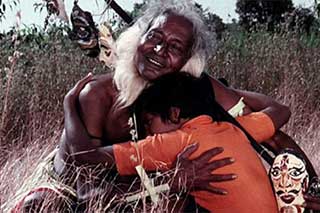
KUMMATTY
Director: Aravindan Govindan
WRITTEN BY: Aravindan Govindan
DIRECTOR OF PHOTOGRAPHY: Shaji N. Karun
STARRING: Ramunni, Master Ashokan, Vilasini Reema, Kothara Gopalkrishnan, Sivasankaran Divakaran, Vakkil, Mothassi, Shankar
COUNTRY OF PRODUCTION: India
LANGUAGE: Malayalam with English subtitles
COLOR INFO: Color
RUNNING TIME: 90 minutes
PRODUCTION COMPANY: General Pictures Corporation
Restored by The Film Foundation’s World Cinema Project and Cineteca di Bologna in association with General Pictures Corporation and the Film Heritage Foundation at L’Immagine Ritrovata laboratory.
Funding provided by the Material World Foundation.
NOTES ON THE RESTORATION:
Restored in 4K using the best surviving element: a vintage 35mm print struck from the original camera negative and preserved at the National Film Archive of India. A second 35mm print with English subtitles was used as a reference.
Color grading was supervised by the film’s cinematographer Shaji N. Karun.
Special thanks to Ramu Aravindan.
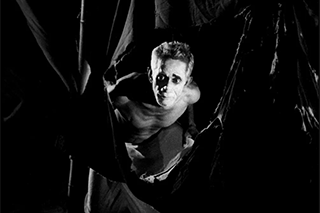
THAMP
CIRCUS TENT, THE
Director: Aravindan Govindan
WRITTEN BY: Aravindan Govindan
EDITING: A Ramesan
DIRECTOR OF PHOTOGRAPHY: Shaji N. Karun
PRODUCER: K. Ravindranathan Nair
STARRING: Nedumudi Venu, Jalaja, V. K. Sreeraman, Bharath Gopi
COUNTRY OF PRODUCTION: India
LANGUAGE: Malayalam with English subtitles
COLOR INFO: Black and White
RUNNING TIME: 129 minutes
PRODUCER: K. Ravindranathan Nair
Restored by Film Heritage Foundation, The Film Foundation’s World Cinema Project, and Cineteca di Bologna at Prasad Corporation Pvt. Ltd.’s Post - Studios, Chennai, and L’Immagine Ritrovata Laboratory, and in association with General Pictures, National Film Archive of India and the family of Aravindan Govindan. Funding provided by Prasad Corporation Pvt. Ltd. and Film Heritage Foundation.
NOTES ON THE RESTORATION:
THAMP was restored using the best surviving element: a Dupe Negative struck from a 35mm print preserved at the National Film Archive of India.

LA NOUBA DES FEMMES DU MONT CHENOUA
Director: Assia Djebar
EDITING: Nicole Schlemmer, Areski Haddadi
DIRECTOR OF PHOTOGRAPHY: Ahmed Sedjane, Cherif Abboun
PRODUCER: Ahmed Sedjane, Cherif Abboun, Hamni Farid
STARRING: Zohra Sahraoui, Aïcha Medeljar, Fatma Serhan, Kheira Amrane, Fatma Oudai, Khedija Lekhal, Noweir Sawsan
COUNTRY OF PRODUCTION: Algeria
LANGUAGE: Arabic and French with English subtitles
COLOR INFO: Color
RUNNING TIME: 115 minutes
PRODUCTION COMPANY: Radio Télévision Algérienne
PRODUCER: Ahmed Sedjane, Cherif Abboun, Hamni Farid
Restored by The Film Foundation’s World Cinema Project and Cineteca di Bologna at L’Immagine Ritrovata laboratory, in collaboration with EPTV and the Cinémathèque Algérienne. Restoration funded by the Hobson/Lucas Family Foundation. Special thanks to Ahmed Bejaoui.
NOTES ON THE RESTORATION:
Restored in 4K from a 16mm which is believed to be the only surviving print of this film. Color grading was finalized with the help of Ahmed Bejaoui.
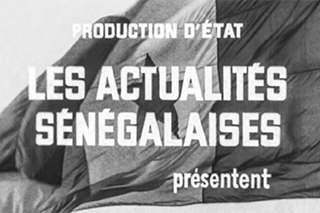
SÉNÉGAL AN XVI
Director: Babacar Gueye and Orlando Lopez
COUNTRY OF PRODUCTION: Senegal
LANGUAGE: French with English subtitles
COLOR INFO: Black and White
RUNNING TIME: 21 minutes
Restored by The Film Foundation’s World Cinema Project and Cineteca di Bologna at L’Immagine Ritrovata laboratory, in collaboration with the Ministère de la Culture et du Patrimoine Historique de Sénégal – Direction du Cinéma. Restoration funded by the Hobson/Lucas Family Foundation.
This restoration is part of the African Film Heritage Project, an initiative created by The Film Foundation's World Cinema Project, the Pan African Federation of Filmmakers and UNESCO―in collaboration with Cineteca di Bologna―to help locate, restore, and disseminate African cinema.
NOTES ON THE RESTORATION:
The 4K restoration was completed using a 16mm print preserved by the Direction du Cinéma in Senegal. With special thanks to Tiziana Manfredi and Marco Lena.
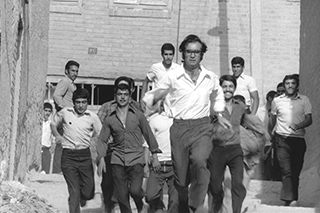
Downpour
RAGBAR
Director: Bahram Beyzaie
WRITTEN BY: Bahram Beyzaie
EDITING: Mehdi Rajaeeyan
DIRECTOR OF PHOTOGRAPHY: Barbod Taheri
PRODUCER: Barbod Taheri
MUSICAL DIRECTOR: Shida Garachedaghi
STARRING: Parviz Fannizadeh, Parvaneh Masumi, Manuchehr Farid, Mohammad Ali Keshavarz, Hossein Kasbian, Jamsheed Layegh, Chehrazad
COUNTRY OF PRODUCTION: Iran
LANGUAGE: Persian
COLOR INFO: Black and White
RUNNING TIME: 129 minutes
PRODUCTION COMPANY: Mehregan Film
PRODUCER: Barbod Taheri
Restored in 2011 by Cineteca di Bologna/L’Immagine Ritrovata laboratory, in association with The Film Foundation’s World Cinema Project and Bahram Beyzaie. Restoration funded by Doha Film Institute.
During Downpour, the equations of commercial and intellectual films were the same. The common morality of the action/drama films of the commercial cinema had a tone of political ideology and social activism. The intellectual films were praised for communicating with the mass culture. In that sense, I don’t want to be popular. Many of these (popular) moralities, in my opinion, are wrong and we are all victims of them. So, I have betrayed my people if I endorse them. I have deviated from the morals of the political parties, hence they have labeled me (inaccessible), not the people. At the heart of my harsh expression, there is a love and respect, for the people, that does not exist in superficial appraisals of the masses. … my audiences are those who strive to go one step further, not those who are the guardians of the old equations nor those who dread self examination and self reflexivity.
–Bahram Beyzaie
I’m very proud that the World Cinema Foundation has restored this wise and beautiful film, the first feature from its director Bahram Beyzaie. The tone puts me in mind of what I love best in the Italian neorealist pictures, and the story has the beauty of an ancient fable – you can feel Beyzaie’s background in Persian literature, theater and poetry. Beyzaie never received the support he deserved from the government of his home country – he now lives in California – and it’s painful to think that this extraordinary film, once so popular in Iran, was on the verge of disappearing forever. The original negative has been either impounded or destroyed by the Iranian government, and all that remained was one 35mm print with English subtitles burned in. Now, audiences all over the world will be able to see this remarkable picture.
–Martin Scorsese
NOTES ON THE RESTORATION:
The source element was a positive print with English subtitles provided by director Bahram Beyzaie. Since this is the only known surviving copy of the film – all other film sources were seized and are presumed destroyed – the restoration required a considerable amount of both physical and digital repair.
The surviving print was badly damaged with scratches, perforation tears and mid-frame splices. Over 1500 hours of work were necessary to complete the restoration.
Image: © Courtesy of Bahram Beyzaie
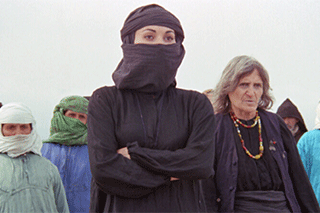
STRANGER AND THE FOG, THE
GHARIBEH VA MEH
Director: Bahram Beyzaie
WRITTEN BY: Bahram Beyzaie
EDITING: Bahram Beyzaie
DIRECTOR OF PHOTOGRAPHY: Mehrdad Fakhimi, Firooz Malekzadeh
STARRING: Parvaneh Massoumi, Khosrow Shojazadeh, Manuchehr Farid, Esmat Safavi, Sami Tahassoni, Valiyollah Shirandami, Reza Yaghuti, Esmaeel Poor Rez, Mohammad Pour Reza
COUNTRY OF PRODUCTION: Iran
LANGUAGE: Farsi version with English subtitles
COLOR INFO: Color
RUNNING TIME: 140 minutes
NOTES ON THE RESTORATION:
THE STRANGER AND THE FOG was restored in 4K using the original camera and sound negatives and was carried out at L'Immagine Ritrovata in 2023. Color grading was supervised by Bahram Beyzaie. With special thanks to Ehsan Khoshbakht and Mozhdeh Shamsai.
